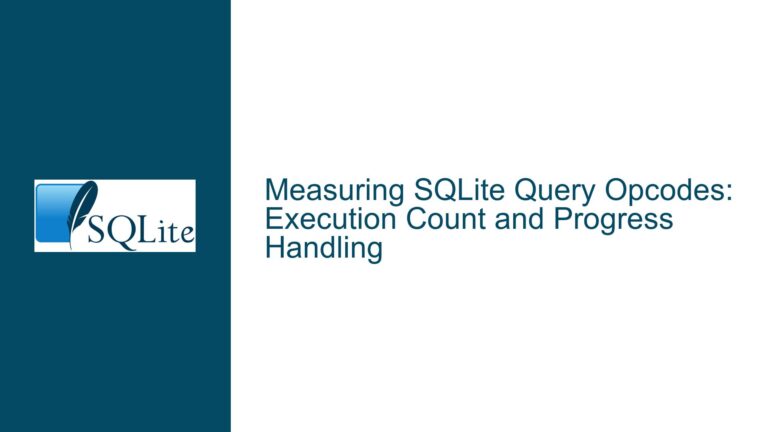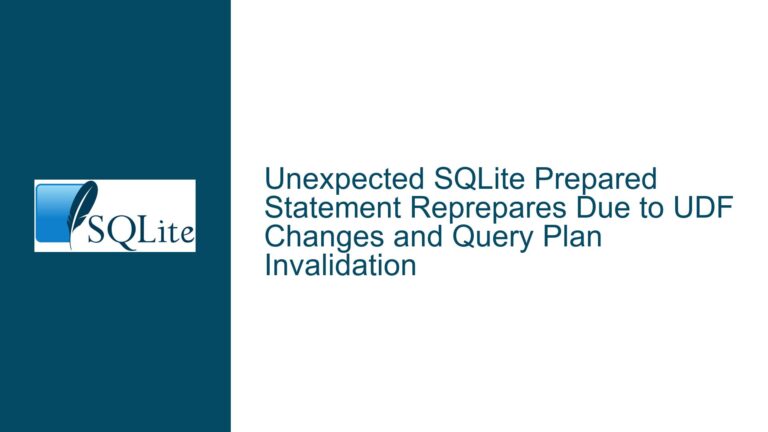Optimizing SQLite Table Appending Between Memory and File Databases
Appending Data Between Memory and File Databases in SQLite
When working with SQLite, a common scenario involves managing data across multiple databases, particularly when one database resides in memory (often used as a buffer) and another is stored on disk. The task of appending data from a table in a memory database to a table in a file database is a frequent requirement, especially in applications that need to periodically flush in-memory data to persistent storage. While the operation seems straightforward, performance considerations and optimization techniques are crucial to ensure efficient data transfer. This guide delves into the nuances of this operation, exploring the underlying issues, potential causes of performance bottlenecks, and detailed troubleshooting steps to optimize the process.
Understanding the Performance Bottleneck in Data Transfer
The core issue revolves around the performance degradation observed when appending data from a table in a memory database (memDB.table) to a table in a file database (fileDB.table). The initial approach involves using an INSERT INTO ... SELECT statement, which, while functional, results in slower-than-expected performance. This slowdown is particularly problematic when dealing with large datasets or when the operation needs to be performed frequently.
The INSERT INTO ... SELECT statement is a standard SQL construct that allows data to be copied from one table to another. In this case, the statement is used to transfer data between tables in different databases. The syntax typically includes specifying the target table (fileDB.table) and the source table (memDB.table), along with the columns to be copied. However, the performance bottleneck arises due to the way SQLite handles the data transfer internally.
One of the primary reasons for the performance issue is the lack of optimization when column names are explicitly specified in the INSERT INTO ... SELECT statement. When column names are provided, SQLite must perform additional checks and mappings to ensure that the data types and structures align between the source and target tables. This overhead can significantly slow down the data transfer process, especially when dealing with large datasets.
Leveraging SQLite’s xfer-Optimization for Faster Data Transfer
To address the performance bottleneck, SQLite provides an optimization known as the "xfer-optimization." This optimization is automatically applied when the INSERT INTO ... SELECT statement is formulated without specifying column names. By omitting the column names, SQLite can bypass some of the internal checks and mappings, resulting in a more efficient data transfer process.
The xfer-optimization works by directly transferring the data from the source table to the target table without the need for intermediate steps. This approach reduces the overhead associated with data type validation and column mapping, leading to a significant improvement in performance. The key to enabling this optimization is to use the following syntax:
INSERT INTO fileDB.table SELECT * FROM memDB.table;
In this statement, the SELECT * clause retrieves all columns from the source table (memDB.table), and the INSERT INTO clause appends the data to the target table (fileDB.table). By not specifying individual column names, SQLite can apply the xfer-optimization, resulting in a faster data transfer.
It is important to note that the xfer-optimization is only applicable when the schema of the source and target tables are identical. If the schemas differ, SQLite will not be able to apply the optimization, and the performance benefits will not be realized. Therefore, ensuring that the table schemas are consistent across both databases is a prerequisite for leveraging this optimization.
Detailed Troubleshooting Steps and Solutions for Optimized Data Transfer
To achieve optimal performance when appending data between memory and file databases in SQLite, follow these detailed troubleshooting steps and solutions:
1. Verify Table Schema Consistency:
Before attempting to transfer data, ensure that the schema of the source table (memDB.table) and the target table (fileDB.table) are identical. This includes checking that the column names, data types, and constraints match exactly. Any discrepancies in the schema will prevent SQLite from applying the xfer-optimization, leading to slower data transfer.
To verify the schema consistency, you can use the following SQL commands:
PRAGMA table_info(memDB.table);
PRAGMA table_info(fileDB.table);
These commands will return the schema information for the specified tables, allowing you to compare the columns and data types. If any differences are found, modify the schema of the target table to match the source table before proceeding with the data transfer.
2. Use the xfer-Optimization Syntax:
Once the schema consistency is confirmed, use the INSERT INTO ... SELECT * syntax to enable the xfer-optimization. This syntax allows SQLite to transfer data directly from the source table to the target table without the need for column name validation, resulting in faster performance.
Example:
INSERT INTO fileDB.table SELECT * FROM memDB.table;
This statement will append all rows from memDB.table to fileDB.table using the xfer-optimization.
3. Monitor and Analyze Performance:
After implementing the xfer-optimization, monitor the performance of the data transfer operation to ensure that the expected improvements are achieved. You can use SQLite’s built-in profiling tools or external performance monitoring tools to measure the execution time and resource usage of the INSERT INTO ... SELECT statement.
If the performance is still not satisfactory, consider the following additional optimizations:
Batch Inserts: If the source table contains a large number of rows, consider breaking the data transfer into smaller batches. This approach can reduce the memory overhead and improve overall performance. For example, you can use a
LIMITclause to transfer a specific number of rows at a time:INSERT INTO fileDB.table SELECT * FROM memDB.table LIMIT 1000;Repeat the process until all rows are transferred.
Disable Indexes and Constraints: Temporarily disabling indexes and constraints on the target table during the data transfer can also improve performance. Once the data transfer is complete, re-enable the indexes and constraints. This approach reduces the overhead associated with maintaining indexes and enforcing constraints during the insert operation.
Example:
PRAGMA foreign_keys = OFF; PRAGMA ignore_check_constraints = ON; -- Perform the data transfer INSERT INTO fileDB.table SELECT * FROM memDB.table; -- Re-enable indexes and constraints PRAGMA foreign_keys = ON; PRAGMA ignore_check_constraints = OFF;Use Transactions: Wrapping the data transfer operation in a transaction can improve performance by reducing the number of disk I/O operations. SQLite performs a commit after each
INSERTstatement by default, which can be inefficient for large data transfers. By using a transaction, you can ensure that all changes are committed at once, reducing the overhead.Example:
BEGIN TRANSACTION; INSERT INTO fileDB.table SELECT * FROM memDB.table; COMMIT;
4. Consider Alternative Approaches:
If the xfer-optimization and additional performance tuning steps do not yield the desired results, consider alternative approaches to achieve the data transfer. One such approach is to use SQLite’s ATTACH DATABASE feature to combine the memory and file databases into a single database connection. This allows you to perform the data transfer using a single SQL statement without the need for inter-database communication.
Example:
ATTACH DATABASE 'file.db' AS fileDB;
ATTACH DATABASE ':memory:' AS memDB;
INSERT INTO fileDB.table SELECT * FROM memDB.table;
DETACH DATABASE fileDB;
DETACH DATABASE memDB;
This approach can simplify the data transfer process and potentially improve performance by reducing the overhead associated with managing multiple database connections.
5. Evaluate Database Configuration:
Finally, evaluate the configuration of both the memory and file databases to ensure that they are optimized for the data transfer operation. This includes setting appropriate page sizes, cache sizes, and journal modes. For example, increasing the page size can improve the efficiency of data transfers, while enabling the WAL (Write-Ahead Logging) journal mode can reduce contention and improve concurrency.
Example:
PRAGMA page_size = 4096;
PRAGMA cache_size = -2000; -- 2000 pages of cache
PRAGMA journal_mode = WAL;
These configuration changes can have a significant impact on the performance of data transfer operations, especially when dealing with large datasets.
Conclusion
Appending data from a table in a memory database to a table in a file database is a common task in SQLite, but it can be challenging to achieve optimal performance. By understanding the underlying issues, leveraging SQLite’s xfer-optimization, and following the detailed troubleshooting steps outlined in this guide, you can significantly improve the efficiency of the data transfer process. Whether you are working with small datasets or large-scale applications, these techniques will help you achieve faster and more reliable data transfers between memory and file databases in SQLite.






